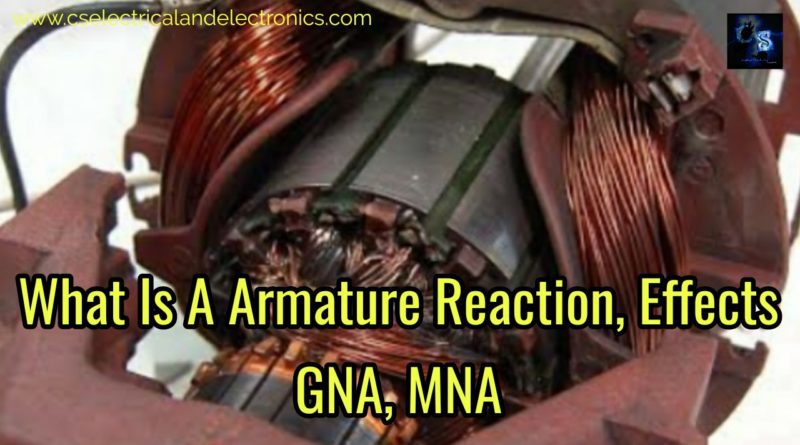What Is A Armature Reaction, Effects, GNA, MNA
Hello Guys, welcome back to my blog. In this article, I will discuss what is armature reaction, its effects, what is the GNA, and the MNA.
If you want an article on some other topic then comment us in the comment section. You can also catch me @ Instagram – Chetan Shidling.
Also read – The Future Scope Of VLSI Engineers.
What Is A Armature Reaction?
The armature reaction means the distortion of the main flux due to the armature flux is called armature reaction. The armature reaction weakens the main flux. The effects of armature reaction reduce the generated voltage and also cause sparking at the brushes.
Now I will explain the concept of armature reaction.
Concept Of Armature Reaction
- 01. I will consider a two-pole generator or motor so that it will be helpful in understanding the concept.
- 02. Assume that the generator or motor is not connected with the load and the main flux is distributed as shown in the below figure in case 01.
- 03. There are three main things to be considered during the armature reaction that is field system, armature, commutator, or brushes.
- 04. The field system produces the main flux. When the current flows through the armature conductors, then the armature flux is produced. when these two fluxes interact with each other the effect is called armature reaction.
- 05. In the DC generator, the positions of the brushes and commutator are decided by the magnetic neutral axis. Suppose if the armature reactions weaken the main flux then the position of MNA (magnetic neutral axis) will be shifted.
- 06. What are GNA and MNA? The geometrical neutral axis is always perpendicular to the stator field axis or main flux axis whereas MNA means magnetic neutral axis the axis where no electromotive force induces in the armature conductor. The brushes are placed in that axis where no emf induces, so brushes are safe.
Now I will consider three cases so that it will be easy for you people to understand.
Case 01: No load is connected to the DC machine

If no load is driven by machine then no current will flows through the armature conductors, no current means no armature flux will induce in the conductor, only the main flux is present in this case and this main flux is symmetrically distributed through the armature conductor.
One more thing guys that the brushes are always placed on the magnetic neutral axis is also called an axis of commutation because the brushes and commutator are placed in that axis. In this case, the MNA and GNA will coincide with each other.
Case 02: No current flows through the field coil and the armature conductor carry current

In this case, no current flows through the field coil and hence no main flux is induced whereas the current flows through the armature conductors and induces the armature flux. We all know that the direction of the armature current is given by flamming righthand rule, for the motors it is the left-hand rule.
In this case, the armature conductors near the north pole induce the flux in the downward direction also the armature conductors near the south pole induce the flux in the downward direction. Thus both will induce a downward direction of flux.
Case 03: Current flows through the field and the armature conductor

Now the machine is on a load that means the current starts flowing through field and armature conductor. When current flows through the field the main flux will induce in the machine and when current flows through the armature conductor the armature flux will also produce in the downward direction.
Both the fluxes induce simultaneously and thus interact with each other the resultant flux is known as armature reaction. When armature reaction occurs the flux is not distributed evenly and the magnetic neutral axis will get shifted, it also reduces the terminal voltage of the machine.
Effects Of Armature Reaction
- 01. The reduction of the total flux in the armature reaction is called the demagnetizing effect.
- 02. The magnetic neutral axis is shifted due to armature reaction.
- 03. The demagnetizing and cross-magnetizing reduces the value of flux per pole.
I hope guys this article may help you all a lot. If you have any questions related to this article, comment below.
Thank You For Reading…Bye…
Also, read:
- 10 Tips To Maintain Battery For Long Life, Battery Maintainance
- 10 Tips To Save Electricity Bills, Save Money By Saving Electricity
- 100 (AI) Artificial Intelligence Applications In The Automotive Industry
- 100 + Electrical Engineering Projects For Students, Engineers
- 1000+ Control System Quiz, Top MCQ On Control System
- 1000+ Electrical Machines Quiz, Top MCQs On Electrical Machines
- 1000+ MATLAB Simulink Projects For MTech, Engineering Students
- 50 Tips To Save Electricity At Home, Shop, Industry, Office
- 50+ Question And Answer On The Substation, Electrical Question
- 500+ Matlab Simulink Projects Ideas For Engineers, MTech, Diploma
- 500+ Projects For Diploma Electrical, Electronics Student, Diploma Project
- Active Cell Balancing Using A Flyback Converter Simulation In Matlab Simulink
- AI Artificial Intelligence Applications In Electric Vehicles | Future?
- AI Tools For Electronic Circuit Design, Which Is Best?
- Applications Of Artificial Intelligence (AI) In Renewable Energy
- Automotive Industry Or VLSI Chip Industry ? Which Is Best?
- Basic Electrical Engineering, Terms, Definitions, SI Unit, Formula
- Basic Electrical Quiz, Take Online Test On Basic Electrical, Electrical Quiz
- Battery C Rate Online Calculator With Time Calculation
- Battery Management Systems In Electric Vehicles, BMS Operations
Author Profile
- Chetu
- Interest's ~ Engineering | Entrepreneurship | Politics | History | Travelling | Content Writing | Technology | Cooking
Latest entries
 All PostsApril 13, 2024What Is TCM, Transmission Control Module, Working, Purpose,
All PostsApril 13, 2024What Is TCM, Transmission Control Module, Working, Purpose, All PostsApril 12, 2024Top 100 HiL hardware in loop Interview Questions With Answers For Engineers
All PostsApril 12, 2024Top 100 HiL hardware in loop Interview Questions With Answers For Engineers All PostsMarch 22, 2024Driver Monitoring Systems In Vehicles, Working, Driver Sleepy Alert
All PostsMarch 22, 2024Driver Monitoring Systems In Vehicles, Working, Driver Sleepy Alert All PostsMarch 10, 2024Top 100 Automotive Interview Questions With Answers For Engineers
All PostsMarch 10, 2024Top 100 Automotive Interview Questions With Answers For Engineers








